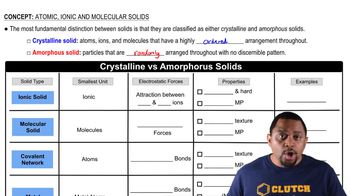(b) What is the coordination number of each cannonball in the interior of the stack?
Ch.12 - Solids and Modern Materials
Chapter 12, Problem 7
Which of these molecular fragments would you expect to be more likely to give rise to electrical conductivity? Explain your reasoning. (a)

(b)
![]()
 Verified step by step guidance
Verified step by step guidance1
Identify the key difference between the two molecular fragments: Fragment I has single bonds only, while Fragment II has alternating single and double bonds (conjugated system).
Recall that electrical conductivity in molecular structures is often associated with the presence of delocalized electrons.
Understand that delocalized electrons can move freely across the molecule, which is facilitated by the conjugated system in Fragment II.
Recognize that the conjugated system in Fragment II allows for the overlap of p-orbitals, creating a 'pi cloud' where electrons can move more freely.
Conclude that Fragment II is more likely to give rise to electrical conductivity due to the presence of delocalized electrons in the conjugated system.

Verified video answer for a similar problem:
This video solution was recommended by our tutors as helpful for the problem above.
Video duration:
1mWas this helpful?
Key Concepts
Here are the essential concepts you must grasp in order to answer the question correctly.
Electrical Conductivity
Electrical conductivity refers to the ability of a material to conduct electric current. This property is influenced by the presence of free-moving charged particles, such as electrons or ions. In molecular structures, the arrangement and type of atoms can determine how easily these charged particles can move, thus affecting conductivity.
Recommended video:
Guided course

Extensive Property Example
Molecular Structure and Bonding
The molecular structure and bonding of a compound significantly influence its physical properties, including conductivity. Structures with delocalized electrons, such as those found in conjugated systems or metals, typically exhibit higher conductivity. The arrangement of atoms in the provided diagrams may indicate the potential for electron mobility, which is crucial for conductivity.
Recommended video:
Guided course

Lewis Dot Structures: Sigma & Pi Bonds
Crystalline vs. Amorphous Structures
Crystalline structures have a well-defined, ordered arrangement of atoms, which can facilitate the movement of electrons, enhancing conductivity. In contrast, amorphous structures lack this order, potentially hindering electron flow. The diagrams depict two different arrangements, and understanding their crystalline nature can help predict their electrical properties.
Recommended video:
Guided course

Crystalline vs Amorphous Solids
Related Practice
Textbook Question
Textbook Question
Which arrangement of cations (yellow) and anions (blue) in a lattice is the more stable? Explain your reasoning. (a)
(b)
Textbook Question
The electronic structure of a doped semiconductor is shown here. (c) Which region of the diagram represents the band gap?
Textbook Question
Shown here are cartoons of two different polymers. Which one would have the higher melting point?
Textbook Question
The accompanying image shows photoluminescence from four different samples of CdTe nanocrystals, each embedded in a polymer matrix. The photoluminescence occurs because the samples are being irradiated by a UV light source. The nanocrystals in each vial have different average sizes. The sizes are 4.0, 3.5, 3.2, and 2.8 nm. (a) Which vial contains the 4.0-nm nanocrystals?
